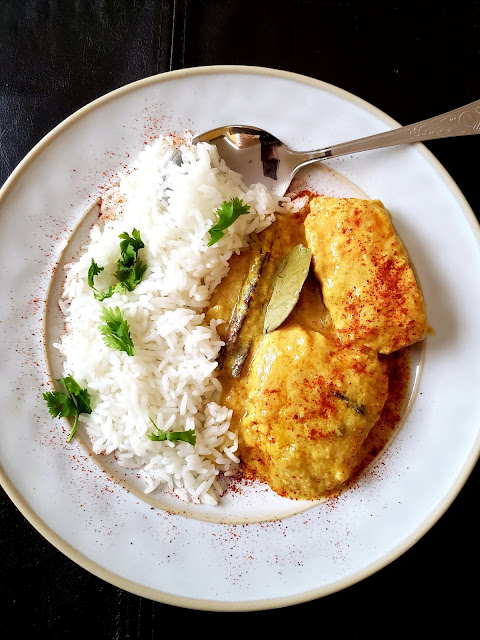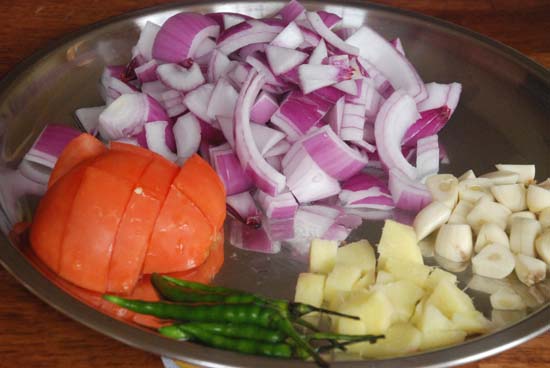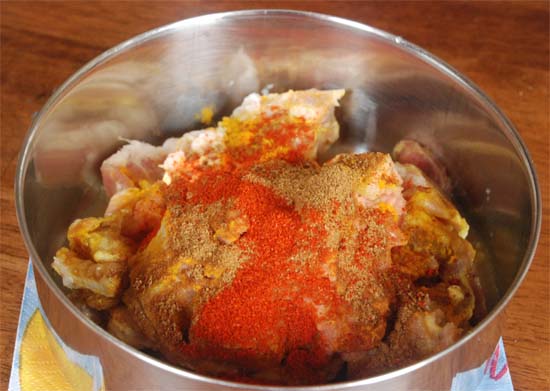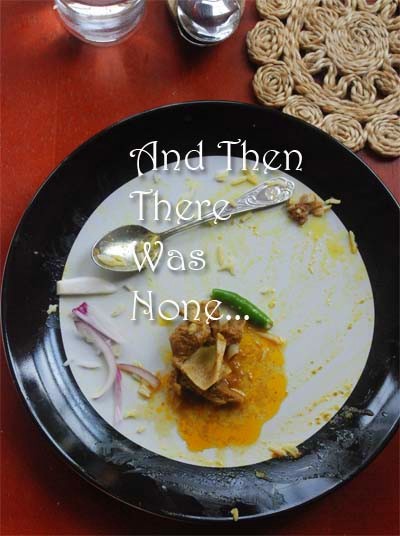Doi Maach -- Fish in Yogurt Sauce
Next week school reopens in my part of the world. After
2 and a half months of late nights, later mornings, lazy breakfasts, no school lunches, no worries of homework, unlimited story book reading time and any hour ice cream time, letting go of summer vacation is not going to be easy.
For anyone.Okay, at least not for me.
 |
| Sauteing Onions to grind into a paste |
Though I was not at the receiving end of those sleep-in mornings and unlimited ice creams, it is my heart that squeezes in this awful manner, thinking of a summer that is slowly gathering up the hem of its laced skirt and preparing to say good bye.This summer has been one of those very laid back kinds, with minimum activities, no summer camps and the girls free to do what they want with their day. Well, for the most part.
 |
| Tempering oil with Whole spices |
There have been several sleepovers, couple of picnics, multiple park visits, visiting friends in neighboring states, grandparents, beach, water parks, a short trip and a birthday party in the park for LittleSis. Nothing else was planned or chalked out and not once did they say they were "bored". BigSis of course read and re-read many books from Percy Jackson to Harry Potter, from the Malory Towers series that my Ma got to some Agatha Christies. LS learned to read pretty well but is yet to get hooked onto its magic, so she kept herself busy with imaginary games involving complex rules, which take more time to explain than play.
I think they had a good summer, kind of like those I had,only with air-conditioning. Listless, long, timeless.
 |
| Add the onion paste |
And now here we are, with school starting on Monday. The prospect of two school buses at my doorstep for the two sisters, wrenching my gut. Darn, I am hitting menopause or what.
The supplies have been bought and labeled by BigSis. The bags have been packed. This is always an exciting part of a new school year though in this case there are no new text books involved. Supplies largely consist of Sharpies, Folders, glue sticks, pens in certain colors, post-its and index cards. For LS it is glue sticks, crayons, glue sticks, color pencils, more glue sticks and did I say glue sticks ? I have no idea what they do in Kindergarten but it sure involves a lot of glue sticks.
 |
| Add fish and sprinkle kashmiri mirch |
The start of a new school year was always exciting during my school days too. One of them was the new
pencil box, which was a coveted treasure and the one thing where my parents gave in to fancy renditions. So I had those magic pencil boxes where the contents would disappear if you opened it a certain way, the two tier ones with Mickie on top, the ones where the scale slid on and doubled as a cover and then shiny camel geometry boxes every year.Close second, were the
new text books with their fresh smell and crisp pages and the Radiant Readers or Gulmohars with their new stories to leaf through.
 |
| In goes tomatoes and green chillies |
There was also the act of covering each of them with
brown paper. A daunting task which my Mother finished for the most part. While in the last few days of vacation, I would be busy completing the handwriting homework I had conveniently procrastinated, Ma would be sitting down with rolls of brown paper, a ruler and a pair of scissors, neatly covering each of the text books. I mostly covered the notebooks and then patiently drew lines on each of those covers to pencil in my name, classroom and section.
 |
| The yogurt which was mixed with half of onion paste, ginger paste, sugar and mixed thoroughly |
BigSis has these things called
book socks to cover her text books, the books that the school provides for the school year. The books mostly stay in class and are to be returned when she moves up. I don't have to pay for them. They are not new. But they are extraordinarily neat with no scribbles on the margins. However I see, she does not feel the oneness with these text books that I once did with mine. I would worry even as the brown paper cover frayed at the ends and started tearing at the spine and never ever leave them face open or upturned. She keeps the books neat but they are not hers to be highlighted, underlined or to make notes.Naturally so she does not feel for them with her heart either. They are just textbooks for the new school year.
It is the folders, pencils and binders which excite her more. And then there are the glue sticks for LS. All six of them.
 |
| Add water and let gravy simmer |
Before I go onto the recipe, I must tell you about this wonderful event where my book is a part of the giveaway. It is hosted by Srivalli of the wonderful blog "Cooking 4 all Seasons". You can participate and try to win a copy.
My book is now also available for UK/Europe/Canada on Amazon at the Amazon.uk, Amazon.ca etc. And it is always there on Amazon and Flipkart. If you have read my book, I would also urge you to rate and review it at these sites as well as on Goodreads. It will be a huge help.
Soon, I will be having a couple of giveaways on my blog too. So stay tuned.
 |
| Almost ready! |
Now to
Doi Machh i.e
Fish in a yogurt gravy features in my list of favorite dishes. Surprisingly this simple dish varies from one Bengali home to the other in the little nuances they add. My Ma’s Doi Maachh is pretty much
traditional with raw onion paste, ginger paste and yogurt in the gravy and that awesome taste is what I grew up with. Then, when I saw my
Ma-in-law add chopped tomatoes to this gravy, towards the end of cooking, I was taken by surprise. But her dish tasted just like Doi Maachh and yet was unique with this touch.
When it was
my turn, I went further. Instead of a raw onion paste, I started
sautéeing the onion lightly and grinding them to a paste which I
then used in the gravy. I was trying to shorten the time it takes to “kashao” raw onion paste. Simple. In my book, I have a version of Doi Maachh where I have added even more twists and turns.
 |
| Tastes best with some rice |
Though traditionally done with fish like Rohu or Carp, I find
salmon perfect in this sweet and spicy yogurt gravy. Today, I will share with you my version of
Salmon diye Doi Maachh, where the salmon is poached in the gravy and the taste is so darn awesome that my daughters lick it up.
And I am sure you will love this too.
Btw, you can use this recipe for the traditional Rui or Rohu fish too. If the fish is not very fresh I would suggest to saute the fish lightly and then proceed with the rest of the steps.
Salmon Doi Maach -- Salmon in a yogurt gravy
Prep Work
Heat Vegetable Oil in a frying pan
Chop a
medium sized onion in large chunks and then saute it until it is soft, pink and translucent. Now cool and make a paste.
Next in a bowl, add about
1/2 cup of thick yogurt. To it add
1/2 of the onion paste
1 tbsp of fresh ginger paste
a pinch of turmeric powder
1/4th tsp of sugar
1/4th cup of water
Beat well
Note for creamier gravy: Soak
2 Tbsp of cashew for 10 minutes and make a smooth paste with little water. Add it to the yogurt above
Clean the fish pieces and lightly rub with
salt and turmeric. Keep aside for half an hour. For salmon, I request the fishmonger to get the skin off the filet and then cut the filet into kabob sized pieces.
Note: Btw, you can use this recipe for the traditional Rui or Rohu fish too. If the fish is not very fresh I would suggest to saute the fish lightly and then proceed with the rest of the steps.
Start Cooking
Heat some more Oil in Kadai/Frying Pan.
Add the coarsely pounded whole garam masala
Elaichi or Cardamom~ 5
Laung or Cloves~ 5
TejPata or BayLeaves~ 2
Dalchini or Cinnamon Sticks ~ 1” stick
When they start sputtering add the
remaining onion paste. Add about
1 tsp of sugar and fry the onion paste till the oil separates.
Add the
fish pieces. Sprinkle
1/2 tsp of Kashmiri mirch and saute until the fish pieces lose their raw color. Don't overcook or fry the fish too much. It will cook in the gravy
Next add
half of a large tomato chopped into small pieces and about 5 slit green chillies. You can also add halved grape tomatoes. Saute for 2 minutes,
Now take the Kadai/Frying Pan off the heat and give it a couple of minutes to cool.
Add the
beaten yogurt/curd and mix with the fish. If you add the yogurt directly when the utensil is on heat the yogurt may curdle so you need to do this.
Put back the Kadai/Frying Pan on heat.
Add
salt as required .Add about
1/2 - 2/3 cup of water at this point. depending on how much gravy you need, you might need more or less water.
Simmer on low heat till the gravy comes to a boil. Let it simmer till the gravy is thick and smooth and the fish is just flaking apart. The texture of the gravy should be silky smooth because of all that yogurt.
Note: the gravy will not dry off totally but will be thick and not watery
Finish off with a little
ghee if you wish and a little
Garam masala powder. Serve with white rice.



















































